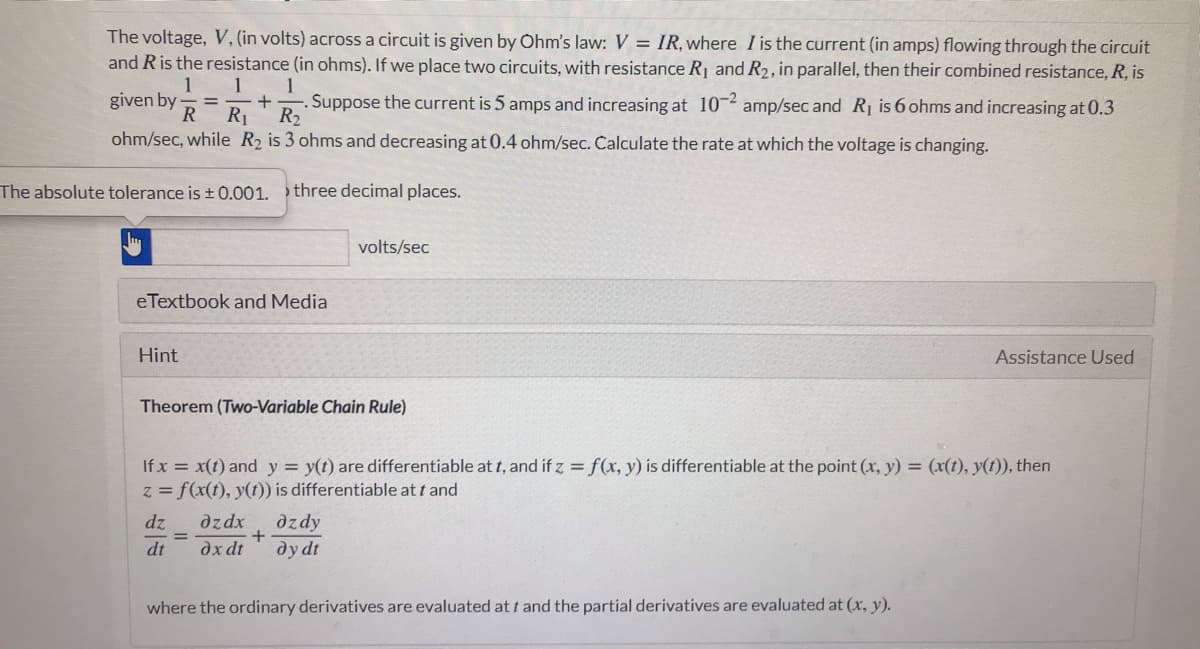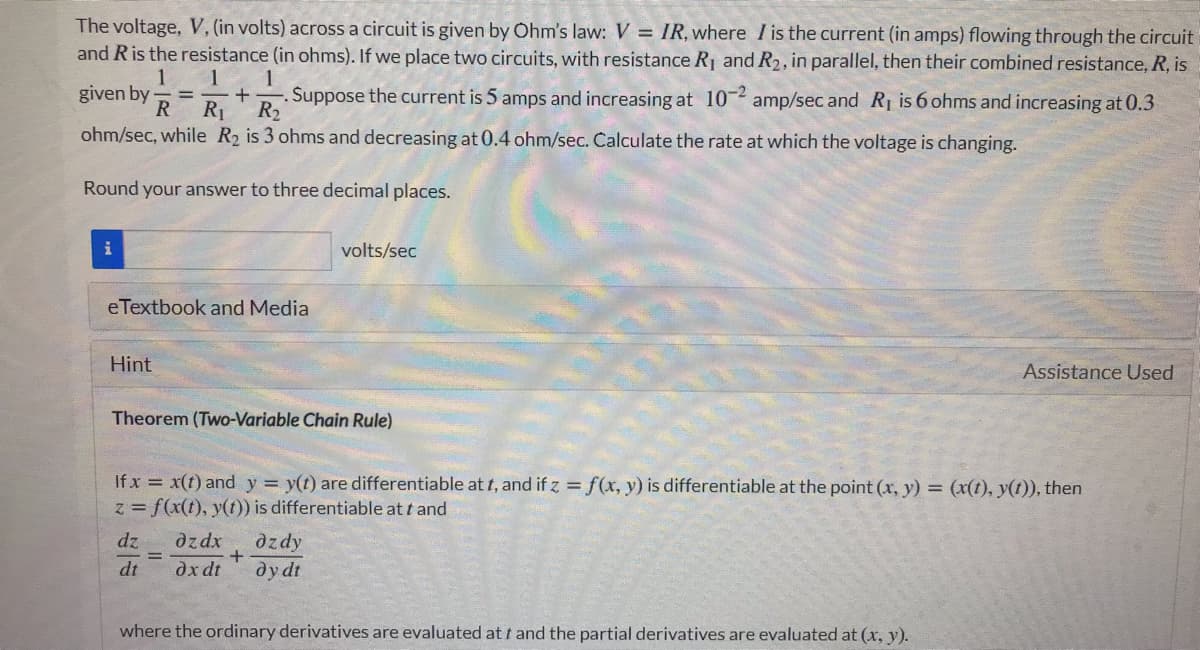The voltage, V, (in volts) across a circuit is given by Ohm's law: V = IR, where I is the current (in amps) flowing through the circuit and Ris the resistance (in ohms). If we place two circuits, with resistance R1 and R2, in parallel, then their combined resistance, R, is 1 given by- 1 1 +- Suppose the current is 5 amps and increasing at 10- amp/sec and R is 6 ohms and increasing at 0.3 R1 R2 %3D ohm/sec, while R2 is 3 ohms and decreasing at 0.4 ohm/sec. Calculate the rate at which the voltage is changing.
The voltage, V, (in volts) across a circuit is given by Ohm's law: V = IR, where I is the current (in amps) flowing through the circuit and Ris the resistance (in ohms). If we place two circuits, with resistance R1 and R2, in parallel, then their combined resistance, R, is 1 given by- 1 1 +- Suppose the current is 5 amps and increasing at 10- amp/sec and R is 6 ohms and increasing at 0.3 R1 R2 %3D ohm/sec, while R2 is 3 ohms and decreasing at 0.4 ohm/sec. Calculate the rate at which the voltage is changing.
Functions and Change: A Modeling Approach to College Algebra (MindTap Course List)
6th Edition
ISBN:9781337111348
Author:Bruce Crauder, Benny Evans, Alan Noell
Publisher:Bruce Crauder, Benny Evans, Alan Noell
Chapter5: A Survey Of Other Common Functions
Section5.2: Power Functions
Problem 17E: Tsunami Waves and BreakwatersThis is a continuation of Exercise 16. Breakwaters affect wave height...
Related questions
Question

Transcribed Image Text:The voltage, V, (in volts) across a circuit is given by Ohm's law: V = IR, where I is the current (in amps) flowing through the circuit
and Ris the resistance (in ohms). If we place two circuits, with resistance R and R2, in parallel, then their combined resistance, R, is
1
given by
R
1
1
Suppose the current is 5 amps and increasing at 10-2 amp/sec and R is 6 ohms and increasing at 0.3
R2
R1
ohm/sec, while R2 is 3 ohms and decreasing at 0.4 ohm/sec. Calculate the rate at which the voltage is changing.
The absolute tolerance is + 0.001. three decimal places.
volts/sec
eTextbook and Media
Hint
Assistance Used
Theorem (Two-Variable Chain Rule)
If x = x(t) and y = y(t) are differentiable at t, and if z = f(x, y) is differentiable at the point (x, y) = (x(t), y(t)), then
z = f(x(t), y(t)) is differentiable at t and
dz
dzdx
dzdy
%3D
dt
dx dt
dy dt
where the ordinary derivatives are evaluated at t and the partial derivatives are evaluated at (x, y).

Transcribed Image Text:The voltage, V, (in volts) across a circuit is given by Ohm's law: V = IR, where I is the current (in amps) flowing through the circuit
and Ris the resistance (in ohms). If we place two circuits, with resistance Rj and R2, in parallel, then their combined resistance, R, is
1.
1
given by
Suppose the current is 5 amps and increasing at 10 amp/sec and R is 6 ohms and increasing at 0.3
R2
R1
ohm/sec, while R2 is 3 ohms and decreasing at 0.4 ohm/sec. Calculate the rate at which the voltage is changing.
Round your answer to three decimal places.
volts/sec
eTextbook and Media
Hint
Assistance Used
Theorem (Two-Variable Chain Rule)
If x = x(t) and y = y(t) are differentiable at t, and if z = f(x, y) is differentiable at the point (x, y) = (x(t), y(t)), then
z =f(x(t), y(t)) is differentiable at t and
dz
dzdx
dzdy
dt
dx dt
dy dt
where the ordinary derivatives are evaluated at t and the partial derivatives are evaluated at (x, y).
Expert Solution
This question has been solved!
Explore an expertly crafted, step-by-step solution for a thorough understanding of key concepts.
This is a popular solution!
Trending now
This is a popular solution!
Step by step
Solved in 2 steps with 2 images

Recommended textbooks for you

Functions and Change: A Modeling Approach to Coll…
Algebra
ISBN:
9781337111348
Author:
Bruce Crauder, Benny Evans, Alan Noell
Publisher:
Cengage Learning

Algebra & Trigonometry with Analytic Geometry
Algebra
ISBN:
9781133382119
Author:
Swokowski
Publisher:
Cengage

Mathematics For Machine Technology
Advanced Math
ISBN:
9781337798310
Author:
Peterson, John.
Publisher:
Cengage Learning,

Functions and Change: A Modeling Approach to Coll…
Algebra
ISBN:
9781337111348
Author:
Bruce Crauder, Benny Evans, Alan Noell
Publisher:
Cengage Learning

Algebra & Trigonometry with Analytic Geometry
Algebra
ISBN:
9781133382119
Author:
Swokowski
Publisher:
Cengage

Mathematics For Machine Technology
Advanced Math
ISBN:
9781337798310
Author:
Peterson, John.
Publisher:
Cengage Learning,

Trigonometry (MindTap Course List)
Trigonometry
ISBN:
9781337278461
Author:
Ron Larson
Publisher:
Cengage Learning


Algebra: Structure And Method, Book 1
Algebra
ISBN:
9780395977224
Author:
Richard G. Brown, Mary P. Dolciani, Robert H. Sorgenfrey, William L. Cole
Publisher:
McDougal Littell